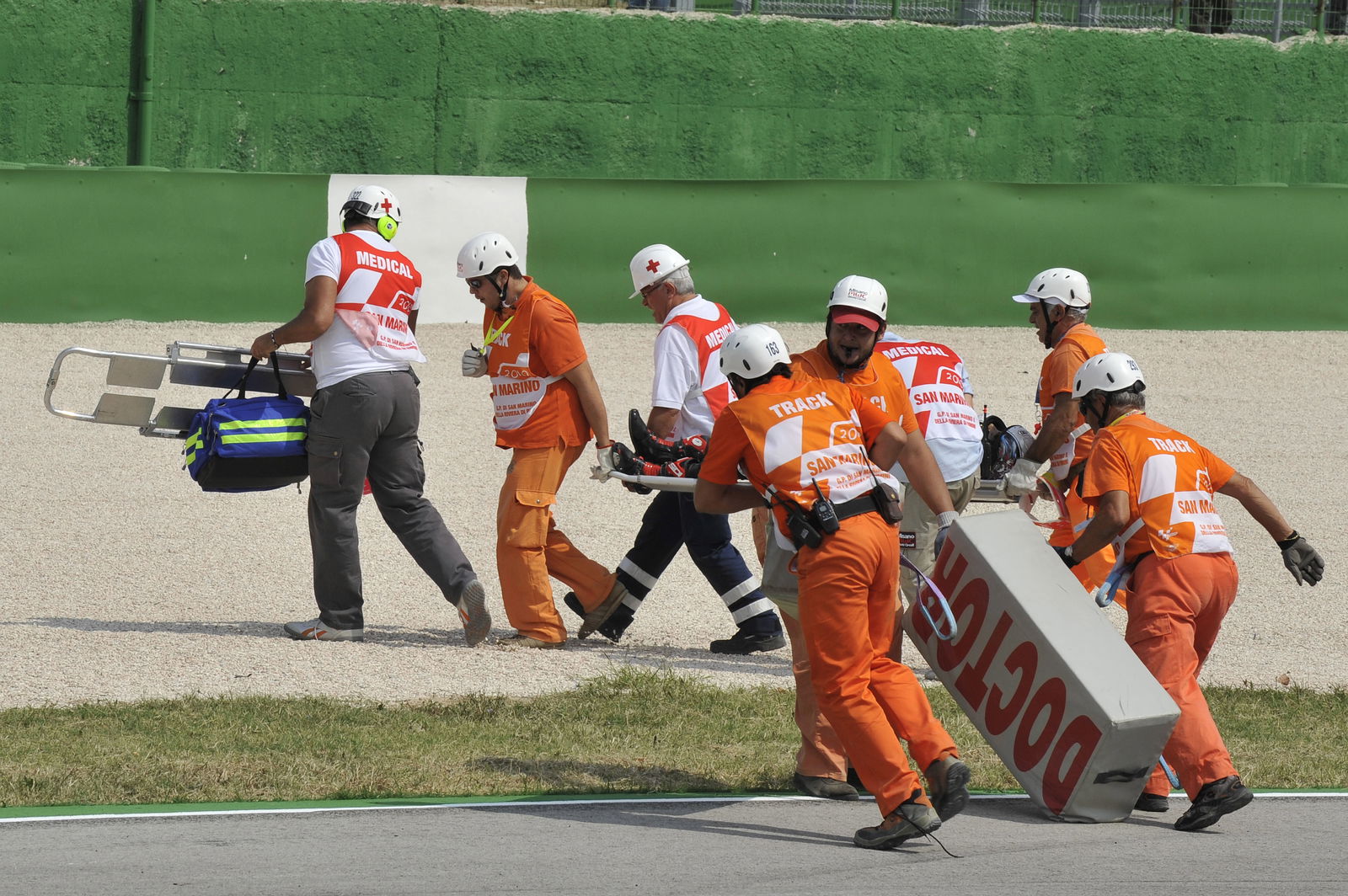Why the Misano Moto2 race wasn't red flagged
When an F1 driver is hurt in a serious accident - for example Felipe Massa's head injury at Hungary 2009 - the session is interrupted (either by a safety car or red flags) and the injured undergo treatment at the scene before being moved.
In Motorcycle Grand Prix, badly injured riders are often moved immediately - as was the case with Shoya Tomizawa in Sunday's Moto2 race, where the Japanese tragically suffered fatal injuries.

When an F1 driver is hurt in a serious accident - for example Felipe Massa's head injury at Hungary 2009 - the session is interrupted (either by a safety car or red flags) and the injured undergo treatment at the scene before being moved.
In Motorcycle Grand Prix, badly injured riders are often moved immediately - as was the case with Shoya Tomizawa in Sunday's Moto2 race, where the Japanese tragically suffered fatal injuries.
It was also the case at Catalunya earlier this year, when Carmelo Morales was quickly taken away from the scene of a huge finish line fall. Morales was later diagnosed with vertebra damage.
Questions have been raised since Sunday's accident as to why the Moto2 race wasn't stopped after Tomizawa's accident, which left the Japanese lying motionless in the track after being hit by two riders.
After all, the Moto2 race at Indianapolis the previous weekend had been red flagged for a far more innocuous incident.
During a special press conference at Misano on Sunday, following the news of Tomizawa's death in hospital several hours after his fall, officials explained that the race wasn't stopped because marshals had moved all the riders and machines before the leaders reached the scene of the accident on the following lap.
But should Tomizawa - and Scott Redding, who sustained a back laceration - have been moved so quickly?
MotoGP Doctor Claudio Macchiagodena was asked that very question at the press conference:
"We don't wait for another problem or more [with the patient]... Many times it is very important to quickly have support. In this situation if you remove quickly, in my opinion, you have more possibility [to help the patient]. Also the paramedics and doctors don't have motorbikes [near them when they are working] on the track. [Away from the track] is more quiet for them to work very well [on the patient]."
Marshals carrying Tomizawa's stretcher seemed to drop one corner of it onto the ground as they walked though the gravel.
After he had reached the ambulance, Tomizawa was treated as follows:
"Behind the track protection we had one ambulance with the respirator inside and we started immediately all the intensive care for him," said Macchiagodena. "I didn't ask for the red flag because I didn't need it.
"After the rider came to the medical centre I had some people asking me why it took a lot of time [for the ambulance to reach the medical centre]. The intensive care started behind the protection of the track. Normally when you have a broken arm the ambulance is the same as a taxi, where you put the rider inside and send him quickly. Now it was very important to have the ventilation and two doctors.
"When he arrived at the medical centre his condition was critical, and we continued the intensive care. We had a lot of doctors but the situation was critical, we had a process for respiration. We checked an abdominal trauma with the scanner because it was a very serious situation not just for the cranial trauma, but for the chest and abdominal.
"He suffered a heart trauma and the best option was to transfer him to hospital in Riccione because it's very close and because we have two doctors in the ambulance who continued the respiration process, and to go by helicopter was very far and not possible for this process. When he arrived in hospital we continued for ten minutes or more... but in the end nothing could be changed for Tomizawa."
The question as to why the following MotoGP race went ahead and was not cancelled as a mark of respect was simple to answer.
"We didn't know until 2.20pm [20 minutes after the start of the MotoGP race] that unfortunately Tomizawa passed away," said Dorna's Javier Alonso.
Tomizawa's fatal injuries were caused by being hit at high speed by other riders, moments after he had fallen off the back of his motorcycle.
Such accidents are impossible to prevent and IRTA safety representative Franco Uncini said that the key to reducing rider injuries in such incidents is through the future development of better protective equipment.
"We can say that what happened was nothing to do with the safety. These kinds of injuries unfortunately could happen at any time," said the former racer. "With the technology we have at this moment it's very difficult to solve this problem, but we are trying to work on this and try and have something that in the future will help us have less damage in this kind of incident."


